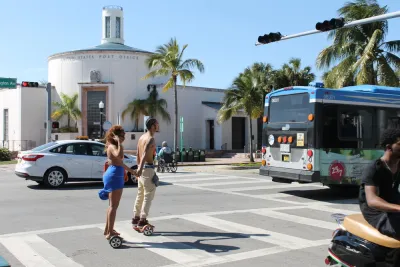The new mobility landscape requires a few key roles from government.

As cities navigate their way through the new mobility landscape and try to figure out what and how they should be regulating new business and service models, two key roles of government are emerging – one to help create a level playing field for all of these services and two to shape these services to help achieve community goals.
A large fear of the shifting models for mobility is that we will end up with a few large, private companies controlling the majority of all of our mobility options. You can imagine a future where Uber, Lyft or Waymo control e-scooter, bikeshare, and ride-sourcing services and we each subscribe to one of their vertically integrated services. One – of the many – large problems with this scenario is that it centralizes control of an absolutely ubiquitous and public need in the hands of a few private entities. Another large concern (and one that could mitigate the first) is that it stifles competition. How would any new mobility concept be able to spread it wings as so many are doing right now if the market is held by a few key players. All innovation would need to happen through these larger companies as gatekeepers and consumers would suffer. The transportation equivalent of current fears about Amazon owning all of our retail options.
To combat this, governments can help create level playing fields for new mobility services. As discussed previously on this blog, the key parts of this are supporting (or creating) platforms that allow shared route/cost/time information, offer a uniform payment platform, and allow for multi-company subscription services. (See article on efforts to do some of this in Germany).
Large question will be what governments actual role is in this — should they host/build the platforms themselves, establish a shared API (such as LADOT’s Mobility Data Specifications (MDS), for instance) along with open competition regulation and allow others to create platforms, or simply create regulations/guides for the outcomes they want and let the market figure out how best to organize around these (most difficult/dubious, in my opinion). Cities will need to balance controlling the process enough to get to desired outcomes while allowing enough flexibility to attract innovators to participate.
The second role governments need to play, once a level playing field is established, is to make sure that playing field has the right shape, incentives and penalties to assure it is supporting the outcomes cities want. Imagine a situation where the open-platform leads to a situation that promotes single occupant car trips and diminishes transit use. Or a situation where this platform leads to certain areas of the city being underserved by services. Cities need to understand what levers exist to shape new mobility services to be equitable, economically supportive of their communities, sustainable, and lead to positive health outcomes. Cities should not be in the business of capriciously or politically favoring one company over another, but they absolutely should be in the business of promoting modes and services that support community goals. In this vein of thinking, Urbanism Next put together a recent report in partnership with the cities of Portland, Seattle and Vancouver that looked at how to regulate AVs (and New Mobility to an extent) with a view towards the cities GHG emission goals.
The mobility landscape is definitely in flux and cities need to think through the outcomes they want, and how best to get there. Allowing for competition and supporting services that support community goals are key steps to doing that.
FULL STORY: CITIES NEED TO CREATE LEVEL PLAYING FIELDS (THAT TILT TOWARDS COMMUNITY GOALS)

National Parks Layoffs Will Cause Communities to Lose Billions
Thousands of essential park workers were laid off this week, just before the busy spring break season.

Retro-silient?: America’s First “Eco-burb,” The Woodlands Turns 50
A master-planned community north of Houston offers lessons on green infrastructure and resilient design, but falls short of its founder’s lofty affordability and walkability goals.

Delivering for America Plan Will Downgrade Mail Service in at Least 49.5 Percent of Zip Codes
Republican and Democrat lawmakers criticize the plan for its disproportionate negative impact on rural communities.

Test News Post 1
This is a summary

Test News Headline 46
Test for the image on the front page.

Balancing Bombs and Butterflies: How the National Guard Protects a Rare Species
The National Guard at Fort Indiantown Gap uses GIS technology and land management strategies to balance military training with conservation efforts, ensuring the survival of the rare eastern regal fritillary butterfly.
Urban Design for Planners 1: Software Tools
This six-course series explores essential urban design concepts using open source software and equips planners with the tools they need to participate fully in the urban design process.
Planning for Universal Design
Learn the tools for implementing Universal Design in planning regulations.
EMC Planning Group, Inc.
Planetizen
Planetizen
Mpact (formerly Rail~Volution)
Great Falls Development Authority, Inc.
HUDs Office of Policy Development and Research
NYU Wagner Graduate School of Public Service


























